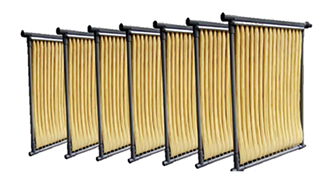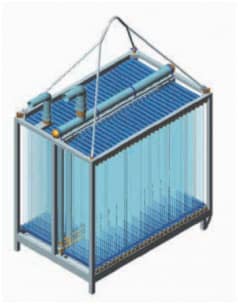All ABOUT MEMBRANE BIOREACTOR (MBR)
Membrane Bioreactor (MBR) is a secondary wastewater treatment process. It is used widely in both industrial wastewater treatment as well as municipal level wastewater treatment.
It is one of several processes which can be used to treat effluent in secondary treatment, as listed below:
- Activated Sludge Process (ASP)
- Extended Aeration System (EAS)
- Membrane Bio-Reactor (MBR)
- Moving Bed Biofilm Reactor (MBBR)
- Sequential Batch Reactor (SBR)
- Up-flow Anaerobic Sludge Bioreactor (UASB)
Configurations of Membrane Bioreactor (MBR) :
There are two main configurations available in the market.
- Submerged
- This filtration system is installed in the main bioreactor vessel or in a separate tank
- It reduces the footprint of the system.
- Side-stream
- This filtration system is installed in outside the bioreactor vessel.
- This system is most commonly used because at the time of maintenance a part of the system can be shut down without stopping the treatment completely.
However, the design of the system is dependent on the design considerations and individual project.

Advantages of UF-MBR technology as compared to a conventional activated sludge system:
There are many advantages of using Membrane Bioreactor (MBR) technology, and recent advances in technology have made it increasingly popular as a method for wastewater treatment.
Some of the benefits include:
- Strong double-supported membrane tubes
- Tight cut-off at 0.03 micron
- Applicable for total suspended solids levels up to 25 g/l biomass
- High tolerance to hypochlorite cleaning
- High flux rates
- Easily interchangeable
- Also available to enhance flux and herewith performance by providing enhanced mixing and efficient removal of the cake
- Chemical consumption only for CIP (Clean-in-place) cleaning

CIP Cleaning
Similar to the filtration medium the cleaning solution is fed into circulation through the membrane from the feed side. For this purpose, either the circulation pump or a separate cleaning pump can be used.
Frequently asked questions:
What is MBR technology in wastewater treatment?
MBR is the blend of a membrane procedure like ultrafiltration or microfiltration with an organic/biological wastewater treatment method, the activated sludge process. It is generally utilized for local and industrial wastewater treatment.
What is the difference between MBR and MBBR?
MBR is a filtration process in which the effluent passes through the MBR membranes removing larger particles. It replaces the need for Ultrafiltration in the treatment plant.MBBR is very different from MBR. In the MBBR system, MBBR media are used to reduce the biological load of the system i.e. BOD and COD. MBBR media are made of different materials like PP, HDPE, PU, etc. HDPE media is the most widely used media.
Advantages and disadvantages of Membrane Bioreactor (MBR)
- Advantages
- Preliminary treatment systems are reduced when MBR is used
- The quality of water treated in MBR based treatment system is similar to that of Ultra-Filtration
- No or limited dependence on the settling of solids
- Disadvantages
- MBR requires skilled manpower
- Membranes of MBR are delicate hence it requires higher level of automation
- Large quantity sludge recirculation is required
What are the Membrane Bioreactor applications?
MBR is most widely used in industrial waste and sewage waste recycling plants.
